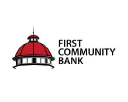
FCBC
First Community Bankshares, Inc.
$33.42
-0.13
(-0.39%)
| Exchange: | |
| Market Cap: | 612.084M |
| Shares Outstanding: | 8.504M |
About The Company
| Sector: | Financial Services | |||||
| Industry: | Banks – Regional | |||||
| CEO: | William P. Stafford II | |||||
| Full Time Employees: | 583 | |||||
| Address: |
|
|||||
| Website: | https://www.firstcommunitybank.com |
First Community Bankshares, Inc. operates as the financial holding company for First Community Bank that provides various banking products and services. It offers demand deposit accounts, savings and money market accounts, certificates of deposit, and individual retirement arrangements; commercial, consumer, and real estate mortgage loans, as well as lines of credit; various credit and debit cards, and automated teller machine card services; and corporate and personal trust services. The company also provides wealth management services, including trust management, estate administration, and investment advisory services; and investment management services. It serves individuals and businesses across various industries, such as education, government, and health services; coal mining and gas extraction; retail trade; construction; manufacturing; tourism; and transportation. As of December 31, 2021, the company operated 49 branches, including 17 branches in West Virginia, 23 branches in Virginia, 7 branches in North Carolina, and 2 branches in Tennessee. First Community Bankshares, Inc. was founded in 1874 and is headquartered in Bluefield, Virginia.
Click to read more…
Revenue Segmentation
EPS
Earnings Call
Income Statement
(* All numbers are in thousands)
Balance Sheet
(* All numbers are in thousands)
Cash Flow Statement
(* All numbers are in thousands)
Analyst Estimates
(* All numbers are in thousands)


